|
With out teeth
|
With teeth
|
No teeth
|
Disclaimer: TW articles written by Fred Fox are the source of most of the information presented on this page, however it has been summarized, revised, and translated. Any deviations, misinformation, or mistakes are mine, as this is not a direct translation of the data and information found in those TW article. If you find an error please let us know using the "Contact Us" page on this website.
1953
new car design would be the most talked about, most written about,
and also the last all new major car redesign in Studebaker's history. This was a Lowey design, but the actual lines were laid down by
Robert Bourke. This design, at least the center sections would
continue on until the end of Studebaker production. It would be
found present in all the Hawks. In the 1956 to 1958 Sedans and Wagons
(albeit with new front and rear fenders, hoods, grilles, and deck
lids.) And in the entire Lark series with a stubbed up front and
rear-end.
Two
separate body styles evolved during the 1953 design cycle. First was
the Sedans (W, F, & Y), later the Coupes (C & K). While the
Sedan design was in progress, Bourke, during his spare time, was
working on a Coupe design (C&K cars.) It was intended as a
styling study, with hopes it might be built as a show car. However,
when Lowey presented Harold Vance and the Studebaker board with the
Coupe design, they decided to put the Coupe series into production.
Some think the sedan design should have been reworked to follow the
coupe design, but there just was not enough time to do that before
fall production would need to start. Remember, the Coupes would not
be available to the public until the 26th of January. Then when the Studebaker front ends did not match up with the Budd
built bodies, further delays resulted. Fred Fox speculates, in his
TW article (February 1995), that the public most likely would not
have been ready to purchase a Sedan, 57 inch high, with limited trunk
space, and very low seats. He also points out quite correctly that
when looking at 1953 Studebaker Sedans we should be comparing them to
Sedans from the big three, not Studebaker's 1953 Coupes. 1953
Studebaker Sedans are lower and more streamlined then anything
offered by Chevrolet, Ford, or Plymouth. These two styling groups
would remain with Studebaker until the South Bend closure. The Coupe
design would evolve into the Hawk series and the Sedan design would
evolve into Sedans, Wagons and eventually Compact Larks. The only
other Studebaker all new car would be the 1963-64 Avanti. What the
two styles have in common is that both are very streamlined and are
nearly devoid of excess chrome, when nearly every other car
manufacture was adding chrome. But hold on, we will fix this problem
in 1955.
Studebaker
offered only 16 models for 1953, across three lines, Champion,
Commander, and Land Cruiser. The Champion's were offered in three
trim levels. Custom (Champion's only), DeLuxe, and Regal. Body
styles were 2 and 4 door Sedans, Starlight Coupe and Starliner
Hardtop. See the chart below for a complete listing of body
styles. There was no Wagon or Convertible in 53.
Champions
and Commanders had an identical model line-up and used the same sheet
metal. (exception, no Commander Custom.) This makes it hard to
tell them apart.
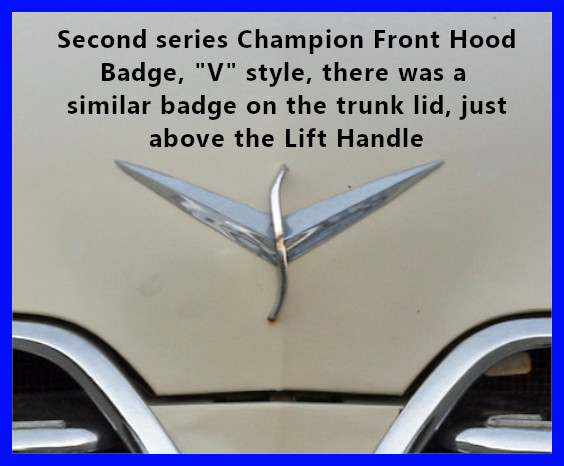  The exterior “Tells” between them are the front
and rear badges. At the beginning of the year both lines have the
tri-star emblem (left photo), front and back, however the Champion has a small “S”
above it where the Commander had a small “8”. Commander's also
have a “Commander” badge on the trunk and a V8 badge on the front
fender vent door. Lowey seems to have been a big fan of the tri-star
and they were seen inside, outside, and on many of the accessory
items. It seems that Mercedes-Benz didn't like the infringement on
their trademark and to keep the peace Studebaker would replace the
front and rear tri-stars with a “V” style badge (upper right photo) where the “S”
or “8” would be larger and contained within the “V”. The
time frame for this change was sometime in January. The exterior “Tells” between them are the front
and rear badges. At the beginning of the year both lines have the
tri-star emblem (left photo), front and back, however the Champion has a small “S”
above it where the Commander had a small “8”. Commander's also
have a “Commander” badge on the trunk and a V8 badge on the front
fender vent door. Lowey seems to have been a big fan of the tri-star
and they were seen inside, outside, and on many of the accessory
items. It seems that Mercedes-Benz didn't like the infringement on
their trademark and to keep the peace Studebaker would replace the
front and rear tri-stars with a “V” style badge (upper right photo) where the “S”
or “8” would be larger and contained within the “V”. The
time frame for this change was sometime in January.
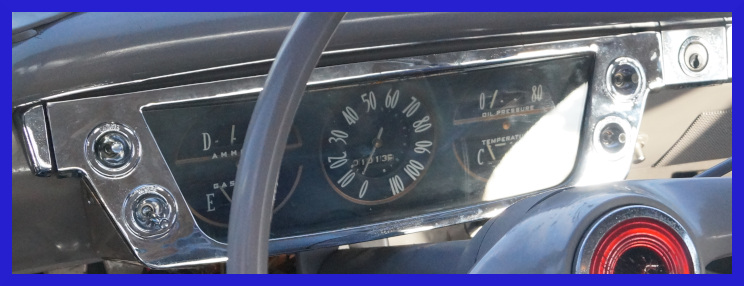 Champion's
had their own unique instrument panel a chrome surround with
three circular gauges under glass. Speedometer in the center, Gas &
Amp to the left, and Temp & Oil Pressure to the right. Flanked by four
toggle switches two on each side. Champion's
had their own unique instrument panel a chrome surround with
three circular gauges under glass. Speedometer in the center, Gas &
Amp to the left, and Temp & Oil Pressure to the right. Flanked by four
toggle switches two on each side.
Coupes have a
side badge just behind the door, circle “S” for Champion's and
V8 for Commanders.
Studebaker
2 door sedans would have, until 1956, a strange ½ rear door without
handles. This design flaw is generated when for what ever reason,
Studebaker had the two and four door sedans share the same
rear-quarter panel. At least in some of the 1955 models they covered
that rear seam with trim. The reverse curve indentation side theme
would also continue for several years ending in Sedans and Wagons in
1956 and Hawks in 1957.
1953
Champion Tells:
Champion
Custom (2 & 4 Door Sedans). No chrome trim, except for the
grille which was the same on all Champions. Painted headlight rings
and taillight housings. Small dog dish hubcaps.
Champion
Deluxe (2 & 4 Door Sedan and Starlight Coupe). Chrome
headlight rings and taillight housings. Stainless trim around the
windshield and rear window, none on the side windows. Small dog dish
hubcaps. A single side trim strip over the rear fender wheel well.
Champion
Regal (2 & 4 Door Sedan, Starlight Coupe and Starliner Hardtop). Same as DeLuxe with the addition of stainless trim around the side
windows and full wheel covers.
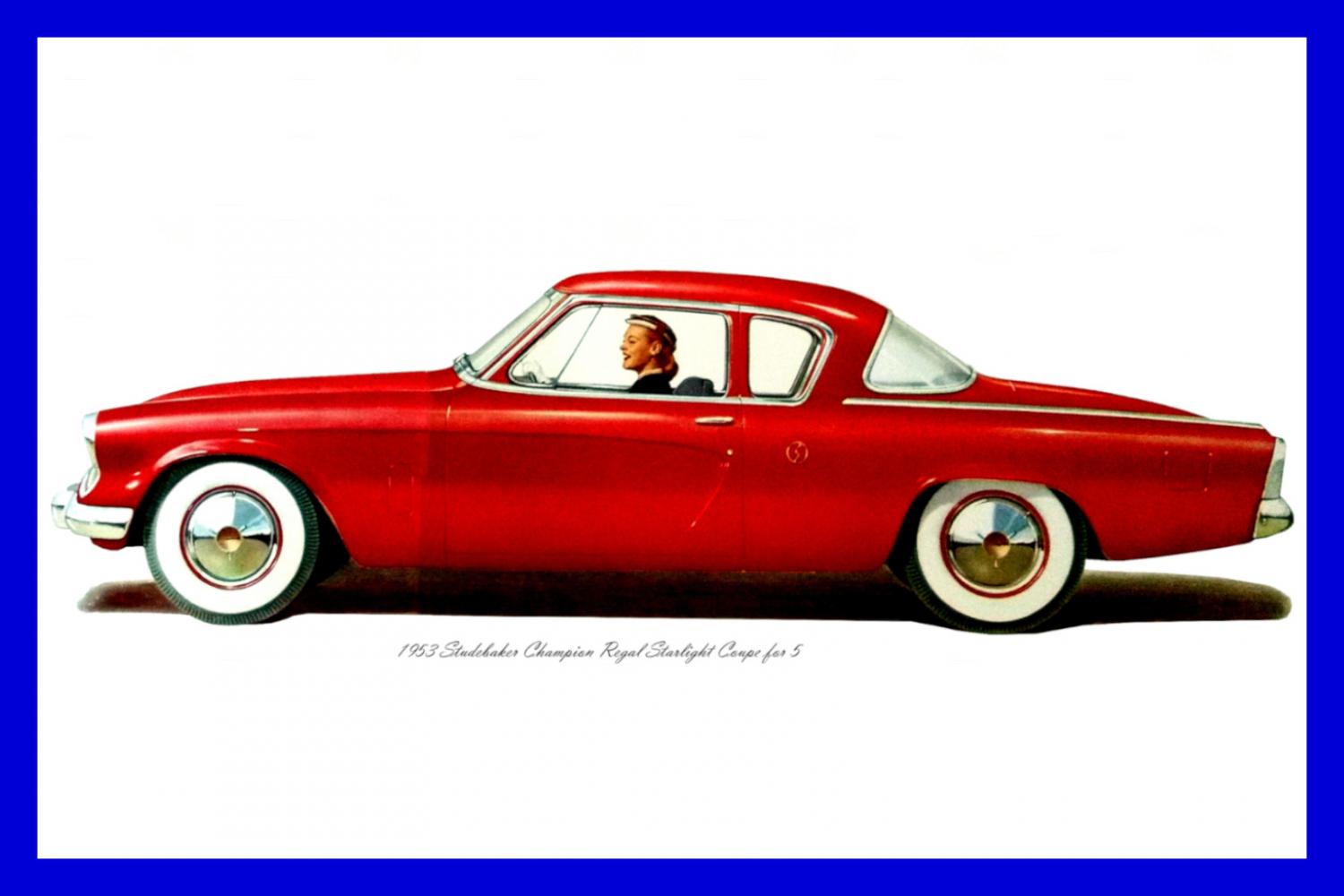 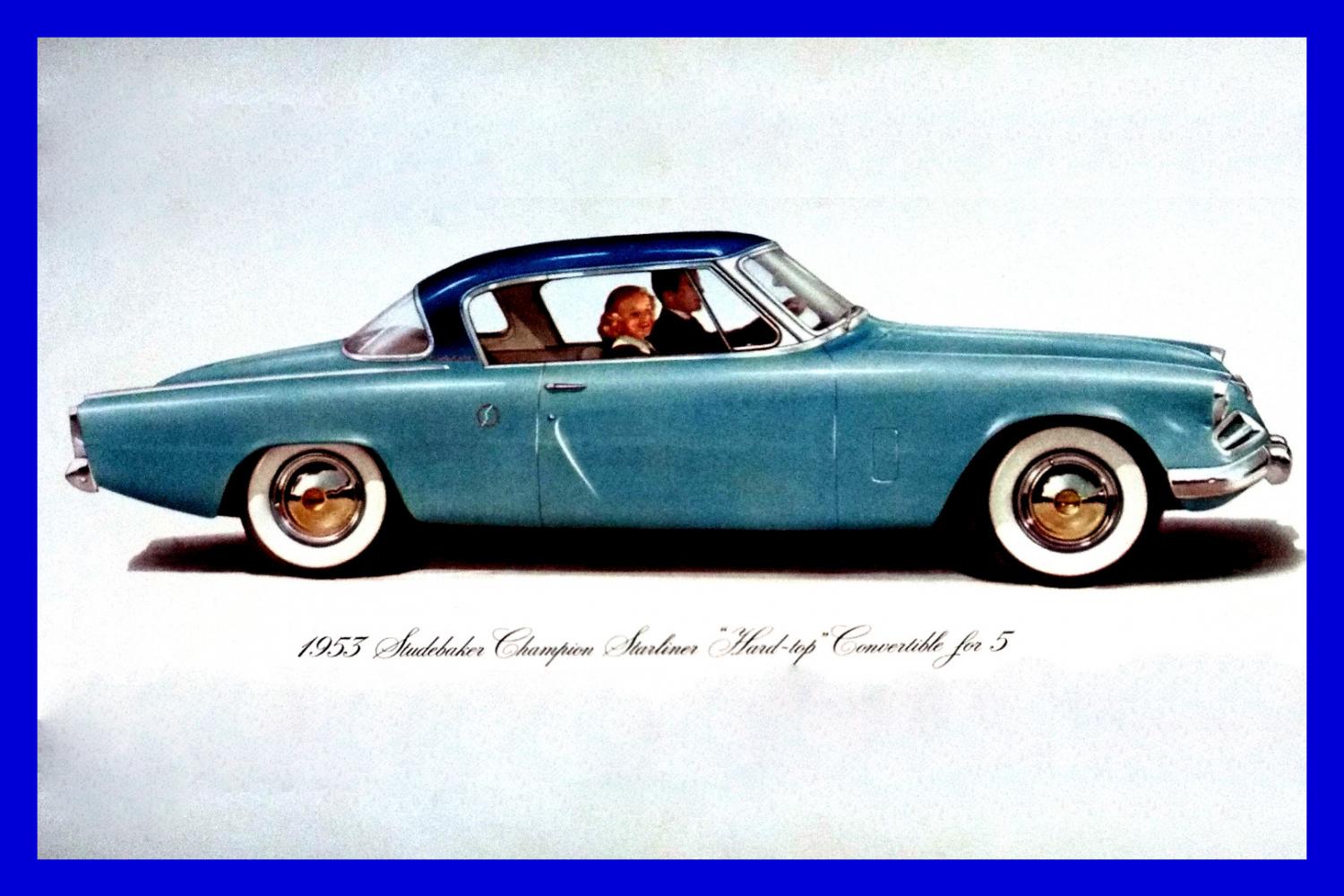 The
coupes (C&K ) did not have the trim strip above the rear-quarter
wheel well, but rather had a trim strip on top of the rear-quarter
panel. The DeLuxe Starlight did not have trim around the side
windows where the Regal Starlight did, however this trim was quite
different from that found on the Regal Sedans. The
coupes (C&K ) did not have the trim strip above the rear-quarter
wheel well, but rather had a trim strip on top of the rear-quarter
panel. The DeLuxe Starlight did not have trim around the side
windows where the Regal Starlight did, however this trim was quite
different from that found on the Regal Sedans.
Mechanical
changes were few. Power Steering was first offered as an option.
Studebaker started with a mechanical PS system, but it proved to be
to noisy and to expensive. Few were made, if any production units.
The final version would be a Saginaw hydraulic unit. An all new
frame was designed for the lower body design. It was lightweight (13
gage stelel) and meant to flex. This did not workout very well as
excessive body noise rapidly resulted, especially in the hardtops.
In later years, these frames would be prone to rust through.
Champions with Automatics had a half-point increase in compression.
Restoration Information:
Click here to see the Options and Accessories listing
Exterior paint information: Was on a label, glued to the bottom of
the glove box. Often these labels now are gone (have fallen off).
However the original paint information can be found on the production
order for your car. You can get a copy for your car's production
order from the Studebaker National Museum.
Floor Covering: Custom
& Deluxe Champions have black rubber floor covering front and
rear. Regal Champions (except Starliners) have black rubber floor
coverings in the front and carpet in the rear. Champion Regal
Starliners have carpet floor coverings in front and back.
Engine
colors: Olive Green for the block, head, pan, and fan. Air
cleaner, generator, starter, coil, voltage regulator, horn relay,
radiator, upper radiator air deflector, and spark plug wire looms
are black. The fuel pump, carburetor, and overdrive relay are natural
metal. The hood lock plate assembly was unpainted. Oil filter units
(factory installed) black body and lid, (dealer installed) oil
filters were generally Fran with orange body and black lid, both
units had bare metal clamps and top bolt. Both normally had decals
on the top and side.
|
1953 Champion Interior Upholstery Materials |
|
Models |
Standard |
Optional at Extra Cost |
|
Champion Custom |
Tan Striped Bedford Cord |
Scarlet Red Pleated Vinyl
Golden Tan Pleated Vinyl |
|
Champion DeLuxe |
Taupe Striped Pile& Cord |
Scarlet Red Pleated Vinyl
Golden Tan Pleated Vinyl |
|
Champion Regal (except K) |
Hickory Beige Striped Woolen Broadcloth |
Scarlet Red Pleated Vinyl
Golden Tan Pleated Vinyl |
|
Champion Regal Starliners |
Airway Grey Nylon
Cardinal Red Nylon1
Scarlet Red Pleated Vinyl 2
Golden Tan Pleated Vinyl 2
Flax Vinyl 3 |
Leather was available on special order, but not listed listed as an option. |
|
1
Late in the model-year, all Starliners ordered with red nylon were
fitted with Flax vinyl cappings and the pleats in the drivers seat
backs were eliminated.
2 Vinyl was an option, but there was no extra charge.
3
Flax (cream color) vinyl leatherette was introduced with the Salem
White/Bombay Red color combination in the spring. It was also
available in mid-year single-tone Bombay Red Starliners. There
is no information to indicate it was available with any other
colors.
Other Notes:
The vinyl and leather pleats were 1 ½ inches wide. Starliners
with Airway Grey nylon seats have Dove Gray vinyl headlining and
trim. Starliners with Red Cardinal nylon seats have Flaxed
Antiqued headlining and trim. |
Exterior Paint Colors: 1953 Studebaker Champions
|
|
Color |
Supplier |
Number |
South Bend
Wheel Color |
Los Angeles
Wheel Cover |
Canadian
Wheel Cover |
|
Velvet Black |
Jones-Dabney |
|
|
|
|
|
Tahoe Green 1 |
Dupont
|
|
|
Tahoe Green |
1 |
|
Chippewa Green |
Cook
|
|
|
|
|
|
Lombard Green 2 |
Jones-Dabney
|
8595
|
|
|
|
|
Tacoma Gray |
Cook
|
|
Comanche Red |
|
|
|
Olympic Gray |
Cook |
|
|
|
|
|
Monterey Beige 1 |
Jones-Dabney
|
|
|
|
1 |
|
Maui Blue |
Dupont
|
|
|
|
|
|
Nocturne Blue 2 |
Jones-Dabney
|
|
|
|
|
|
Manchester Maroon 2 |
Cook |
8580 |
|
|
|
|
Ivory Mist |
|
8574 |
|
|
Ivory Mist |
|
Coral Red |
|
8577 |
|
|
|
|
Bombay Red 3 |
Cook |
8650 |
|
|
|
|
Two-Tones (Available first only on Starliner hardtops - K Bodies.)
(Later available as an extra cost option on Starlight Coupes - C Bodies.) |
|
|
|
|
|
Wheel Cover |
Notes |
|
|
|
1105 |
2465 |
|
1 Not available from
the Canadian plant.
2 One source indicates
this color or color
combination was not
available from the Los
Angles (Vernon) plant.
3 Spring color.
4 Canadian production
only.
5 Was also a 1950-51
car color |
|
|
|
|
2466 |
|
|
|
|
|
2467 |
|
|
|
|
|
2468 |
|
|
|
|
|
2469 |
|
|
|
|
|
2470 |
|
|
|
|
|
2471 |
|
|
|
|
|
2472 |
|
|
|
|
|
2473 |
Comanche Red |
|
|
|
|
2473 |
|
|
|
|
|
2474 |
|
|
Salem White 3 |
Bombay Red 3 |
|
2501 |
Bombay Red |
|
Color Used Only On Two-tone Models |
Non-body Wheel Cover |
|
Color |
Supplier |
Number |
Color |
Supplier |
Number |
|
Salem White 3 |
Cook |
8653 |
Comanche Red 5 |
Cook |
8337 |
| Interior Metal Trim Color |
|
Color |
Supplier |
Number |
| Loma Gray |
Cook |
8598 |
|
Note: Bombay Red Starliners with Flax vinyl upholstery had Monterey Beige metal trim. |
1953 Studebaker Champion Series 14G, 116.51
/ 120.52 in. wheelbase
|
Model |
No. Doors |
Passengers |
Original Price |
TW Original Price |
No. Produced |
|
DeLuxe Starlight Coupe (C3)2 |
2 |
5 |
$1,687.00 |
$1,868.00 |
9,422 |
|
Regal Starlight Coupe (C5)2 |
2 |
5 |
$1,765.00 |
$1,995.00 |
16,066 |
|
Custom Sedan (F1)1 |
2 |
6 |
$1,574.00 |
$1,735.00 |
3,983 |
|
DeLuxe Sedan (F3)1 |
2 |
6 |
$1,661.00 |
$1,831.00 |
4,564 3 |
|
Regal Sedan (F5)1 |
2 |
6 |
$1,739.00 |
$1,917.00 |
2,968 |
|
Custom Sedan (W1)1 |
4 |
6 |
$1,606.00 |
$1,767.00 |
5,496 |
|
DeLuxe Sedan (W3)1 |
4 |
6 |
$1,692.00 |
$1,863.00 |
17,180 |
|
Regal Sedan (W5)1 |
4 |
6 |
$1,770.00 |
$1,949.00 |
17,897 |
|
Regal Starliner HT (K5)2 |
2 |
6 |
$2,038.00 |
$2,116.00 |
13,058 |
|
Total |
90,634 |
Serial Number SB 1,197,501 - 1,274,000 LA 917,701 - 927,400 CA 745,101 - 753,300
Starting Engine Number SB 1,004,001 - 1,090,000 CA C-46,501 – C-55,781
Source: CCD
production numbers and models exactly match TW except for the
production number for F3's where TW reported exactly 3,000 (7,564)3
more. Most likely a data error on either TW or CCD. CCD's Original
price is about, but not exactly, 10% under the TW price. James
Moloney's Crestline Studebaker Cars, agreed with TW on price, for the
models they listed.
With the
release of the all new Lowey designed 1953 Studebaker, little is done
this year, especially to the exterior. However,the Conestoga two
door station wagon in both DeLuxe and Regal trim is a new model (D)
for this year. Designed under the direction of Robert Bourke (Lowey
and Associates). It used most of the sheet metal from the “F”
series two door sedan's, but did have it's own unique rear-quarter
panel.
Exterior “Tells” for 1954
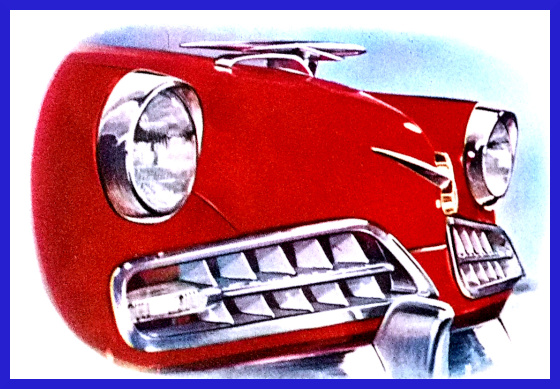 Other
changes were in the appearance of the grille, which was nearly the
same, except for five vertical teeth on each side, attached to the “53” center bars.
The taillights were new, with different
housings and lens. The lenses now mounted with two screws (see photo right) and are round instead of
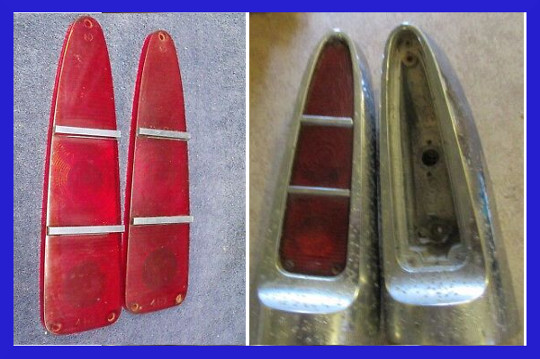 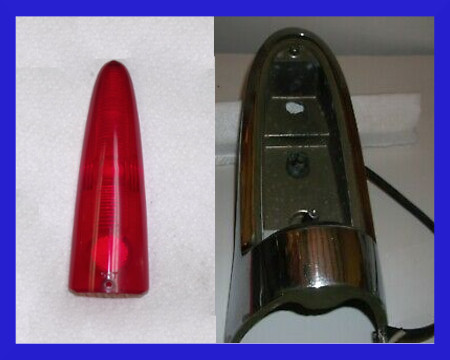 flat. The bars that segmented the 53 lens (see photo left) are
gone. The front bumper guards are redesigned, now blunt (flat) at
the front and used on all models (See the grille photo.) The DeLuxe and Regal Sedans and
Wagon have a new Hood Ornament as standard equipment, Custom and C &
K models could add a Strat-o-styled hood ornament using AC-2610.
Custom sedan models have painted headlight rims and taillight
housings and no side trim and Dog dish hubcaps. No hood ornament.
DeLuxe & Regal have chromed headlight
rings and taillight housings and dog dish hubcaps. DeLuxe sedans and wagons (looking at
sales brochures) have the narrow side trim on the rear quarter from
last year. New hood ornament.
New longer and wider side trim is fitted to Regal sedans
and wagons.
The Champion Circle "S" is also added just behind the front fender vent door. New hood ornament and full rim hubcaps.
The trunk handle/name plate is redesigned to include the
trunk lock which was
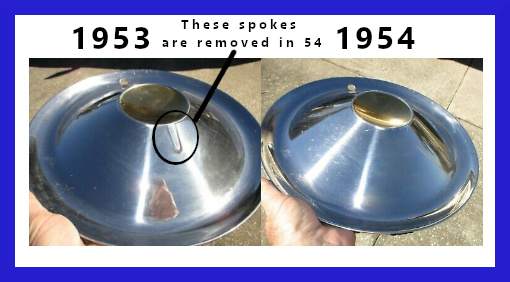 separate on the “53's”. The “53” had
“SUDEBAKER” centered in handle, now left of the lock, it said
“STUDEBAKER” and right of the lock it said either “CHAMPION”
or “COMMANDER”. This theme would also be seen on the 1955
models. The three radiating lines on the dog dish and full wheel covers (right Photo) are
eliminated. The exterior sheet metal, for each body style, is the
same for Champions and Commanders, as it had been since 1951. The instrument panels would remain different.
Interior's
are the second greatest change, (after the new wagons) and involve
new colored fabrics and interior paint, selected to harmonize with
the exterior color, not done since mid-year 1940 to 1942 cars.
The Custom
seats are gray “gold-striped” nylon fabric with vinyl trim. The
door panels have two sections separated with three narrow straight
chrome strips and no arm rests.
The DeLuxe seats are “rippleweave”
cord with a matching deeper shade of nylon-face fabric. DeLuxe door panels have three sections separated
with four narrow straight chrome trim strips and have arm rests.
The Regal
seats are “striped cord” with nylon-face fabric on the bolsters
and caps. Regal, like Deluxe, have door panels have three sections separated
with four narrow straight chrome trim strips and have arm rests.
Interior color combinations are not listed for Custom trim, but it
seems that DeLuxe trim is limited to three colors and Regal trim had
four colors. The steering wheel, garnish molding, dash, door panels,
headliner, and floor covers are color matched on all trim levels.
The C & K cars have different three section door panel, with one
large section on the K car being pleated. The rear center arm rest is a removable
version, unique to 1954 only.
The hand brake handle changes
from pistol grip to horizontal T-bar. Only minimal
 change is made to
the dash and instrument panel of the Champion. This would be the
last year the Champion and Commander would have different instrument
panels.
Mechanical
changes were few. The frame is modified with an extended engine rear
cross member on sedans and wagons. An additional frame cross member
is added to the C&K bodies. Both much needed improvements. The
front brake drum size is increased to 10 inches and self adjusters
are eliminated in favor of manual adjustment. Engine compression
ratio is increased by ½ a point, but HP remains at 85. New clutch
petal shaft part are used and the Automatic Drive valve body is
modified so the transmission now starts in low gear instead of
intermediate. Tubeless tires are introduced during this model-year.
In June
of 1954 Studebaker introduced the Ambulet in both the
Commander and Champion lines, a Conestoga wagon fitted with special
emergency equipment that included sirens, red flashers, and cots. Also offered in the commercial line would be a Sedan Delivery,
essentially a wagon with the rear windows blanked out and the rear
seat eliminated.
On
October 1st, 1954 Studebaker and Packard would become the
Studebaker-Packard Corporation. Neither company would significantly
improve it's status from the agreement, especially Packard.
Restoration
Information:
Engine
color: Olive green with black generator, starter, coil, spark
plug cable bracket and air cleaner. Fan olive green (some times
black). Carburetor and fuel pump were natural.
|
1954 Exterior
Paint Colors |
Passenger Car
Two-tones (Upper/Lower)
(Not
Available on Champion Custom Model) |
|
Passenger Car Solid Paint Colors |
Combo No. |
Colors |
|
Safford Cream |
Sandusky Beige |
1158 |
Azore Green/Lance Green1 |
|
Azore Green |
Elko Grey3 |
1159 |
Lance Green/Azore Green |
|
Vista Green |
Cadet Grey |
1161 |
Ontario Blue/Safford Cream |
|
Lance Green1 |
Chadron Red |
1162 |
Nocturne Blue/Vienna Blue |
|
Vienna Blue |
Shoshone Red |
1163 |
Sandusky Beige/Chadron Red |
|
Alberta Blue1 |
Velvet Black |
1164 |
Sandusky Beige/Shoshone Red |
|
Nocturne Blue2 |
|
1165 |
Ontario Blue/Elko Gray3 |
|
Station Wagon
Solid Colors |
1166 |
Shoshone Red/Sandusky Beige |
|
Azore Green |
Elko Grey5 |
1167 |
Velvet Black/Safford Cream |
|
Lance Green1 |
Shoshone Red |
1168 |
Velvet Black/Chadron Red |
|
Alberta Blue1 |
Mesa Tan |
? |
Cadet Grey/Nocturne Blue2 |
|
Vienna Blue |
Safford Cream5 |
? |
Nocturne Blue/Cadet Gray4 |
|
Cadet Grey |
Velvet Black |
? |
Ontario Blue/Cadet Gray2 |
|
Shasta White6 |
|
|
|
Station Wagon
Two-tones (Upper/Lower) (Not
Available on DeLuxe Conestogas) |
|
Combo No. |
Colors |
|
1200 |
Mesa Tan/Safford Green5 |
|
1201 |
Ontario Blue/Elko Gray5 |
|
1204 |
Nocturne Blue/Vienna Blue |
|
1205 |
Lance Green/Azore Green |
|
1206 |
Azore Green/Lance Green1 |
|
1207 |
Sandusky Beige/Shoshone Red |
|
1208 |
Elko Grey/Alberta Blue1 |
|
South Bend Only1
Canada Only2 Not Available
Canada3 Mid-year color combo NA
from LA Plant4
Los Angeles Only5
Extra Cost color for Ambulet Only6 |
1954
Studebaker Champion Series 15G, 116.51
/ 120.52 in. wheelbase
|
Model |
No. Doors |
Passengers |
Original Price |
TW Original Price |
No. Produced |
|
DeLuxe Starlight Coupe (C3)2 |
2 |
5 |
$1,795.00 |
$1,972.00 |
7,042 |
|
Regal Starlight Coupe (C5)2 |
2 |
5 |
$1,895.00 |
$2,080.00 |
5125 |
|
Custom Sedan (F1)1 |
2 |
6 |
$1,595.00 |
$1,758.00 |
2,653 |
|
DeLuxe Sedan (F3)1 |
2 |
6 |
$1,705.00 |
$1,875.00 |
4,449 |
|
Regal Sedan (F5)1 |
2 |
3 |
$1,805.00 |
$1,953.00 |
1,066 |
|
Custom Sedan (W1)1 |
4 |
5 |
$1,635.00 |
$1,801.00 |
2860 |
|
DeLuxe Sedan (W3)1 |
4 |
6 |
$1,745.00 |
$1,918.00 |
9,668 |
|
Regal Sedan (W5)1 |
4 |
6 |
$1,845.00 |
$2,026.00 |
7,286 |
|
Regal Starliner HT (K5)2 |
2 |
6 |
$2,045.00 |
$2,241.00 |
4,302 |
|
DeLuxe Conestoga Wagon (D3)1 |
2 |
6 |
$1,195.00 |
$2,187.00 |
3,910 |
|
DeLuxe Conestoga Wagon (D5)1 |
2 |
6 |
$2,095.00 |
$2,295.00 |
3074 |
|
Total |
51,435 |
Serial
Number SB 1,274,001 – 1,316,500 LA 927,401 – 932,500 CA
753,301 – 758,200
Starting
Engine Number SB 1,090,001 – 1,138,000 CA C-55,782 – C-60,500
Source:
Turning Wheels August 1986. CCD production numbers and models
exactly match TW. CCD's Original price is about, but not exactly 10%
under the TW price. James Moloney's Crestline Studebaker Cars,
agreed with TW on price, for the models they listed.
This
is the year that Studebaker decided to get into the chrome and color
game with the big three, GM, Ford, and Chrysler. Harley Earl of GM
fame, once stated “if a little chrome is good, then a lot of chrome
is better.” Some would say that this departure from the Lowey,
“remove all the trim”, 1953 design, was radical and on-necessary. Others think it is the most typical 50's look Studebaker ever
produced. No question it was a mix of both, the slopping 53 design,
and lots of chrome. Love it or leave it.
Several
things happened this year which made 1955 cars survivors. First the
built quality was much better then 53 & 54, especially the early
1953's. The chrome is better then either of the prior two years and
this is the first year vinyl covered wiring is introduced. A lot
more options are available which made the cars more user friendly,
like power steering, power brakes, power windows, and power seats. Even air conditioning is offered on V8's, however little help to the
Champion line.
Exterior “Tells” for 1955
The
Champion and Commander Models for 1955 were identical, as were their
sheet-metal and trim. Even 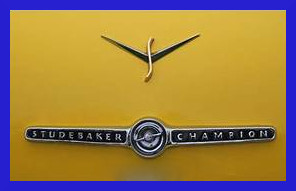 the dash is nearly identical across the
entire Studebaker line-up. The thing that clearly identifies
Champions from the exterior, is that they do not have a rear-quarter
panel name badge like Commanders and Presidents. The upper badge on
the trunk has an “S” where Commanders and Presidents had an “8””
and the right side of the deck lid lift handle said “Champion”
instead of “Commander” or “President”. The basic difference
between Champion's and Commander's was the engine. Commander's were
V8's and Champion's were flat-head sixes. the dash is nearly identical across the
entire Studebaker line-up. The thing that clearly identifies
Champions from the exterior, is that they do not have a rear-quarter
panel name badge like Commanders and Presidents. The upper badge on
the trunk has an “S” where Commanders and Presidents had an “8””
and the right side of the deck lid lift handle said “Champion”
instead of “Commander” or “President”. The basic difference
between Champion's and Commander's was the engine. Commander's were
V8's and Champion's were flat-head sixes.
Champion's
came in three trim levels:
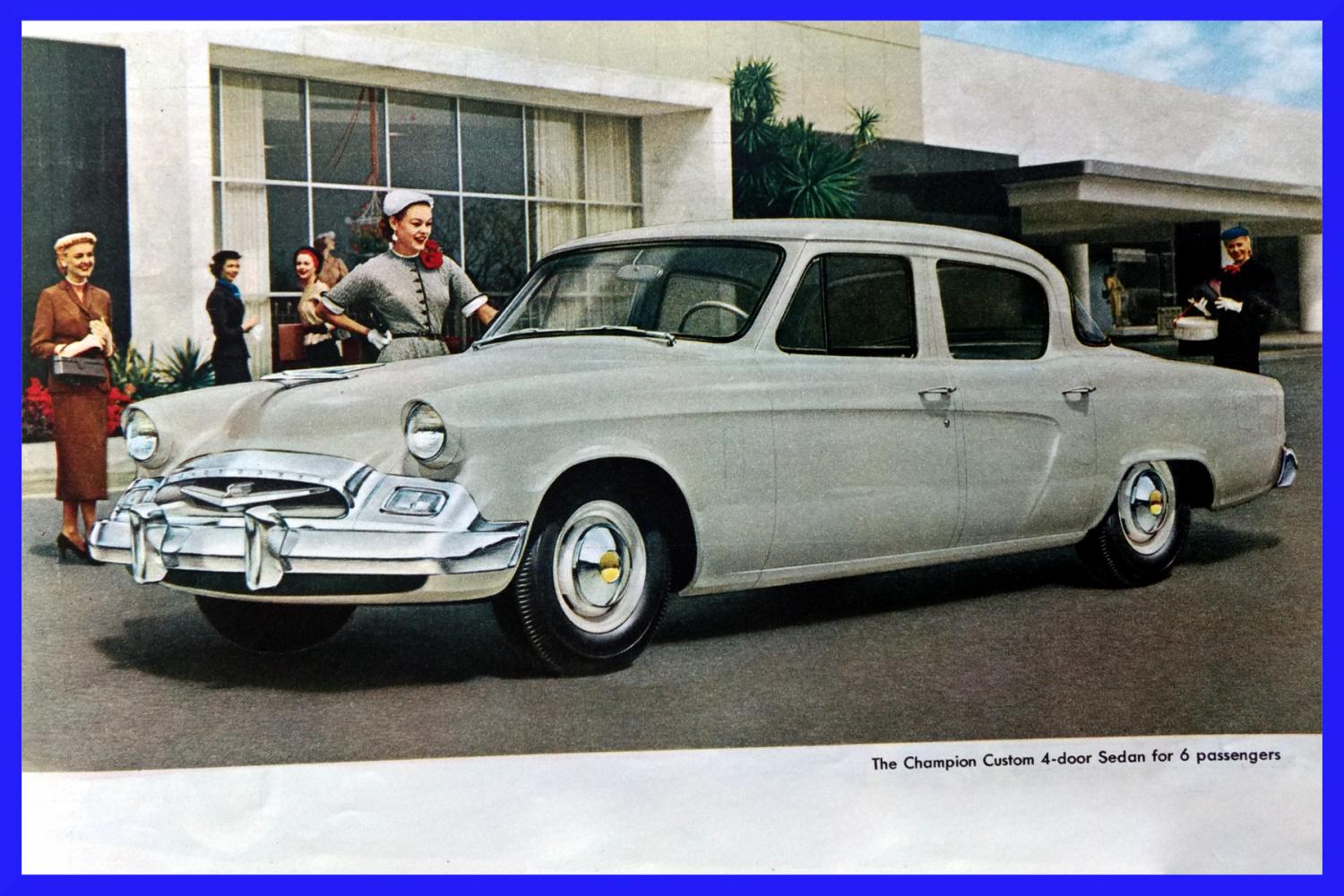
Custom,
two models, a 2dr Sedan and a 4dr Sedan. These were very spartan
cars offered only in solid colors. They had no side trim and no
stainless around the windows or belt-line moldings. The 2dr Sedan,
still featured that ½ door with no handle, just below the rear
window, caused by using the 4dr rear-quarter panel, that had been
seen in 1953 and 1954. They also had painted headlight rims and
taillight housings (making them easy to ID).
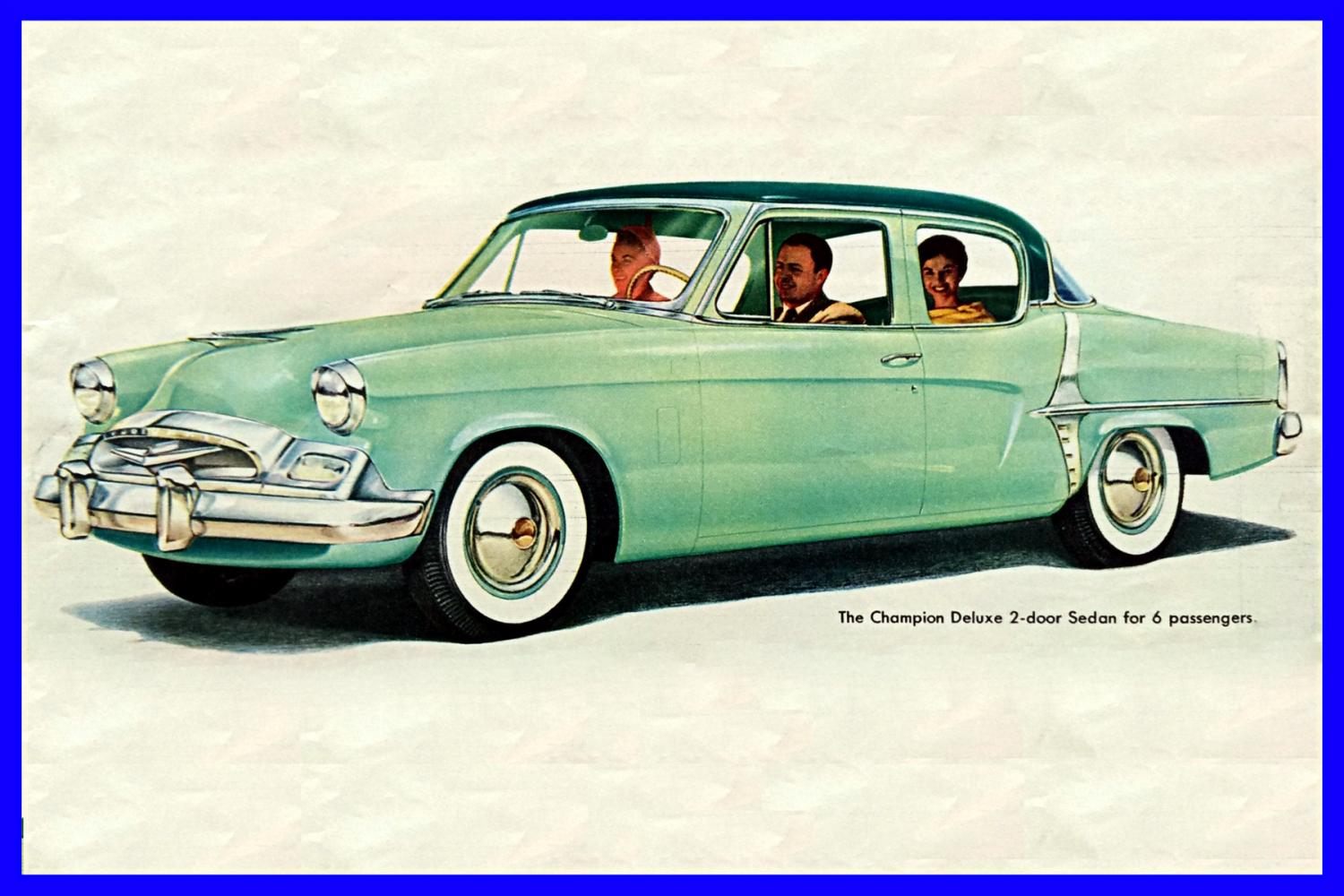 Deluxe, four models, a 2dr Sedan, a 4dr Sedan, a Coupe, and a 2dr Conestoga Station Wagon. Deluxe had chrome headlight rims, chrome taillight housings, a
stainless belt-line, and stainless trim around the windows (except
wagons). The 4dr Sedan had a full length narrow side molding
just below the door handles. The 2dr Sedan has a wide vertical trim
piece that covers that seam at the rear “C” pillar and then has a
horizontal narrow trim extending thru the center of the vertical
trim, longer in the rear then in the front. The Coupe has window and
belt-line treatment like the sedans. It has no side trim, but has
trim on top of the rear quarter-panels. The wagon has no
stainless around the side windows and no lower side trim, but
does have front and rear window stainless and a belt-line molding. Deluxe, four models, a 2dr Sedan, a 4dr Sedan, a Coupe, and a 2dr Conestoga Station Wagon. Deluxe had chrome headlight rims, chrome taillight housings, a
stainless belt-line, and stainless trim around the windows (except
wagons). The 4dr Sedan had a full length narrow side molding
just below the door handles. The 2dr Sedan has a wide vertical trim
piece that covers that seam at the rear “C” pillar and then has a
horizontal narrow trim extending thru the center of the vertical
trim, longer in the rear then in the front. The Coupe has window and
belt-line treatment like the sedans. It has no side trim, but has
trim on top of the rear quarter-panels. The wagon has no
stainless around the side windows and no lower side trim, but
does have front and rear window stainless and a belt-line molding.
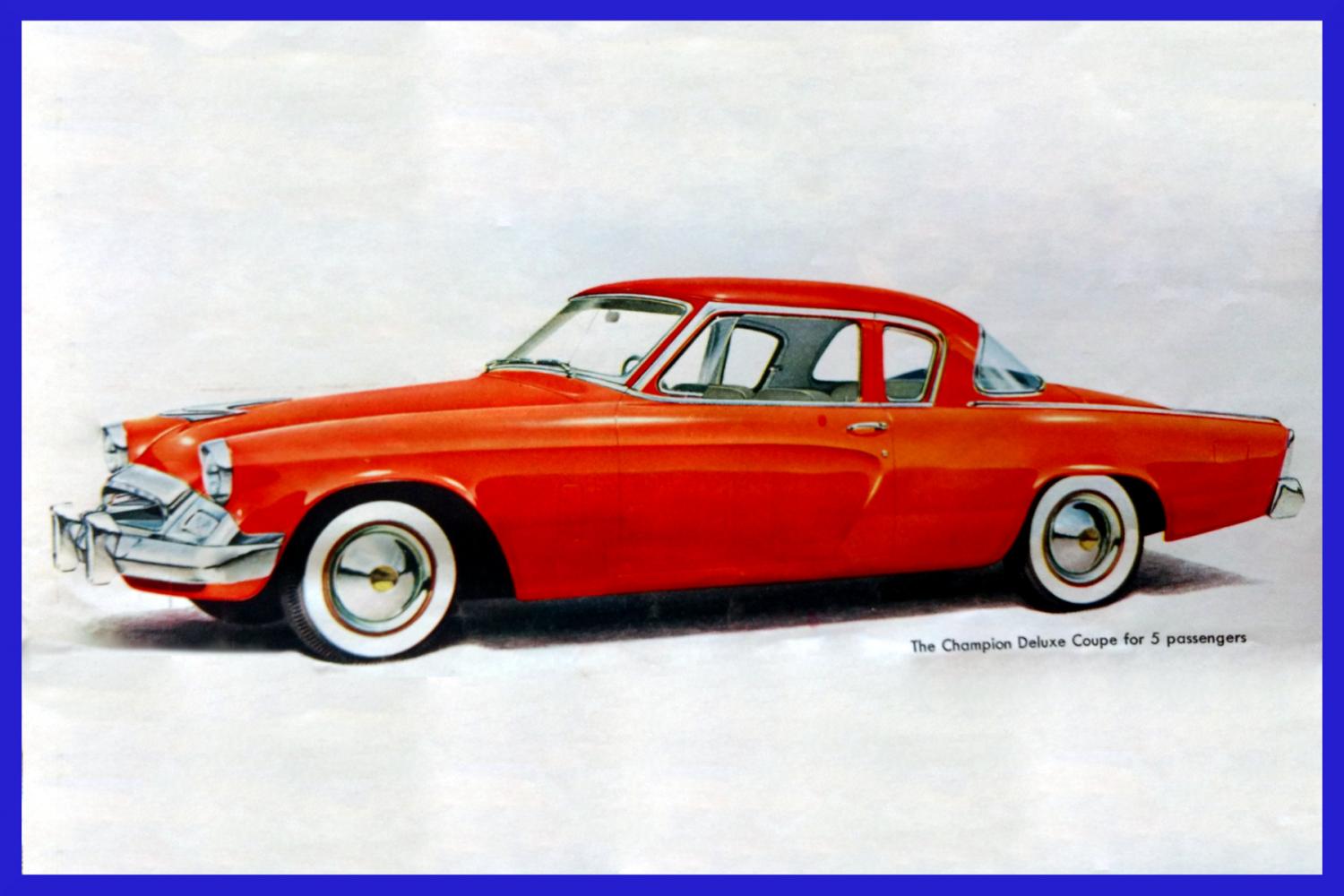 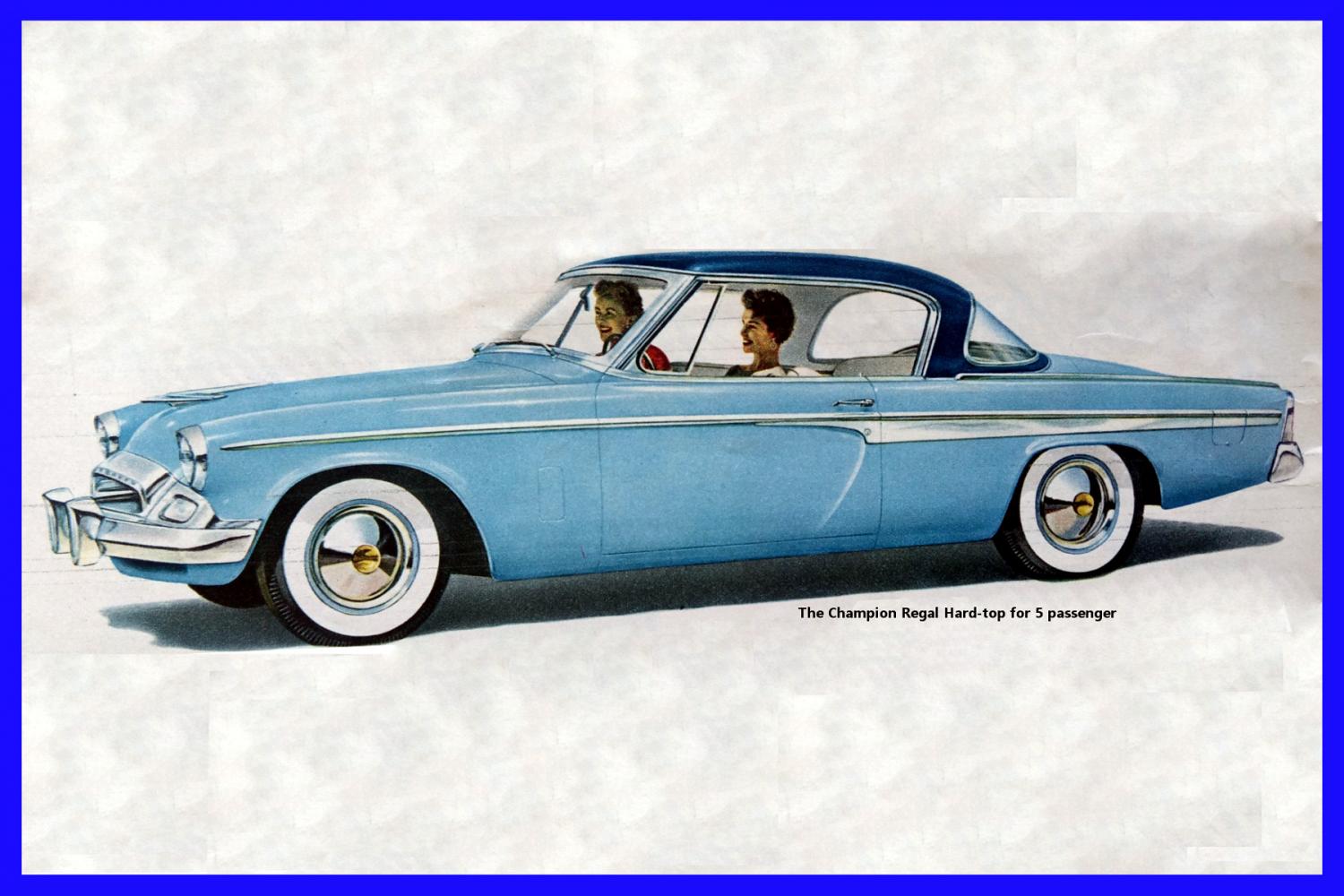 Regal, four models, a 4dr Sedan, a Coupe, a Hard-top, and a 2dr Conestoga Station Wagon. Regal has all the trim of the Deluxe cars, plus the “Butter Knife”
(sweep spear) trim which extended just below the Deluxe side trim. The Coupe and Hardtop have full length side trim with the “Butter
Knife” treatment. The Regal Wagon has it's own unique side trim,
which is wider and ends with a flair right at the reverse indented
curve behind the door. Regal Champion Wagons have “Studebaker”
badges on the rear quarters, where the Deluxe Wagon did not. Regal
Wagons and Regal 4dr Sedans have a stainless mini-sun visor above the
windshield. Both Champion Wagons have a round “S” plastic
medallion built in the belt-line molding at the “B” pillar and
have “Conestoga” badge on the tailgate. Regal, four models, a 4dr Sedan, a Coupe, a Hard-top, and a 2dr Conestoga Station Wagon. Regal has all the trim of the Deluxe cars, plus the “Butter Knife”
(sweep spear) trim which extended just below the Deluxe side trim. The Coupe and Hardtop have full length side trim with the “Butter
Knife” treatment. The Regal Wagon has it's own unique side trim,
which is wider and ends with a flair right at the reverse indented
curve behind the door. Regal Champion Wagons have “Studebaker”
badges on the rear quarters, where the Deluxe Wagon did not. Regal
Wagons and Regal 4dr Sedans have a stainless mini-sun visor above the
windshield. Both Champion Wagons have a round “S” plastic
medallion built in the belt-line molding at the “B” pillar and
have “Conestoga” badge on the tailgate.
The
bodies for 1955 are a continuation of the 1953 design (1954 for
wagons). The big news was a new grille with a floating center
insert. The center section was the same across all models, but the
side sections which held the parking light were not interchangeable
between the Coupe/Hardtop & Sedan/Wagon. Except for the
Conestoga Wagon rear bumper, the bumpers are made larger, thus the
1953 & 1954 bumper guards and fog lights will not fit 1955 cars. These bumpers are now single piece design. This bumper design would
be used (with some bolt hole changes) on the front of 1956 Sedans &
Wagons and later yet on 1964 C&K models. The Conestoga rear
bumper was the same as 53 & 54 Sedans and 54 Wagons. The 55
Wagon 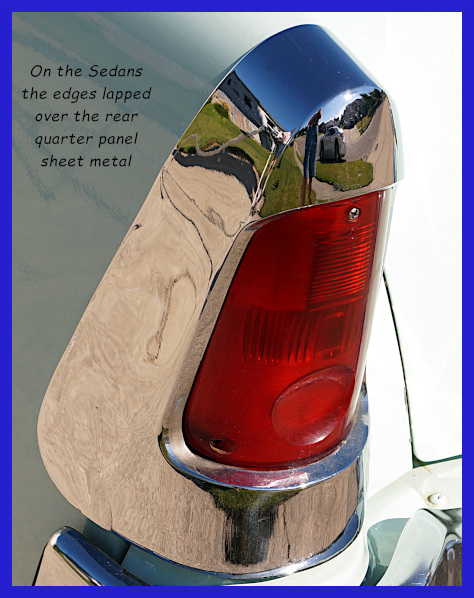 taillight housing and lens were the same as 1954, but the
Sedans and C&K cars had redesigned units. The Sedans and C&K
housing and lens were not interchangeable as the Sedan design was
much larger. The Sedan taillight housing actually wrapped around the
edge of the rear fender. Robert Bourke was in charge of all the 1955
styling. taillight housing and lens were the same as 1954, but the
Sedans and C&K cars had redesigned units. The Sedans and C&K
housing and lens were not interchangeable as the Sedan design was
much larger. The Sedan taillight housing actually wrapped around the
edge of the rear fender. Robert Bourke was in charge of all the 1955
styling.
As
mentioned earlier, two-tone paint in bright colors was certainly in
for 1955 and could be had on Deluxe or Regal Sedan models for $18.28, or on Coupes for $22.58, standard on Hardtops. Interior fabrics
and colors were also spectacular, designed by Eleanor LeMaire and
changed several times during the model-year. A new instrument
cluster is used, featuring two large round dials mounted in a grooved
panel (gold on early models) with four toggle switches mounted, two
on each side. Signal light indicators and a “S” are in between
the dials. Commander's had a V8 in this location. Regal models had
full circle horn ring with a gold horn button. Champion Regal
Hardtops had front and rear carpeting, Regal Sedans & Coupes had
rear floor carpeting with black rubber on the front floor. All other
models featured all black rubber flooring. For the third year in a
row, the Coupe and Hardtop rear center arm rest is redesigned. In
1953 it was fixed, in 1954 it was removable, and this year it is made
to hinge down between the seats.
Mid-year
(January) Studebaker would release in the Sedan and Wagons models
it's Ultra Vista models (wrap-around windshield). The C&K models
would not get this treatment. This was a significant modification
requiring a new windshield, new windshield trim, new front doors, new
wind wings & glass, new instrument panel, and a modified cowl. The same “instruments would be used in the new dash, but the bezels
would be changed. The toggle switches would be replaced with
push-pull switches and the “S” between the dials would be
eliminated. Early Champion Sedan and Wagon models have odd numbers
(F1,F3, W1, W3, D3, & D5). The later Ultra Vista Models would
have even numbers (F2, F4, W2, W4, D4, & D6). Several new
accessories would be required which included radios and Climatizer. Three new options are also introduced in January, power windows,
power seat, and air conditioning. Air was only available on V8's so
this did not effect the Champion line.
No information about the interior fabrics is provided here. However we know the number of color and fabric combinations, along with added color and fabric changes at mid-year, may have created the largest number of interior choices Studebaker would ever offer. Those
interested in addition information should study the following
publications:
-
Dealer
Studebaker Perspectives on Value showroom book; both the
original and revised pages.
-
Model
changes 1955 Studebaker catalogs, dated September 1954 and
December 1954.
-
Studebaker
Passenger Car and Truck Color Combination Paint Chart
catalog, June 1955. This catalog takes up 1/3 page for 1953
interiors and 2/3 page for 1954 interiors , and five pages for 1955
interiors.
-
Beautiful
New Colors for Spring folder.
-
Questions
and Answers catalog, October 1954
-
The
showroom sales catalogs (D 217—9-54 and D 221—1-55), the
Speedster sales folder provide some interior information.
That
flat-head six engine (185 Victory Six) finally gets some help with an increase in the
stroke, to raise the cubic inches to 185.6 and HP to 101. Makes dragging that Commander sheet metal around a little easier. One other subtle change was to increase the diameter of the Champion tailpipe to 1 3/4 inch (1/4 inch increase.) All 1955 Studebaker's were ignition key start. Champion Sedans and Wagons run on 116.5 inch wheelbase while C&K run on 120.5 inch wheelbase.
Restoration
Information:
The
early engine color was Alberta Blue (a 1954 exterior paint color). Later engines were painted Turquoise (the exact date of the change is
unknown).
Item
that are engine color are the fan, factory installed oil filter (all
parts), and power steering pump and pulley (if equipped). Dealer
installed oil filters were usually Fram with orange canister body and
black lids, the bolt being bare metal.
Champion air cleaner and oil filler cap are Cherokee Red (some earlier cars
may have had black air cleaner & oil filler cap as Studebaker
used up 1954 inventory).
Items
painted black include generators, starter, battery hold down,
radiator fan shroud, hood rod, upper radiator air deflector, and
power steering reservoir (if equipped).
Some
generators may have natural metal end plates and pulley. Other
natural metal items are battery hold down nuts, upper hood lock, coil
bracket, throttle linkage, carburetor, and fuel pumps.
Power
Brake boosters were painted silver with black attachment brackets,
later units were all black.
Decals
are fitted to the air cleaner, oil filter canister, and oil filter
lid. The Champion engine decal (Victory Six) was placed on the spark
plug wire guide (early engines may not have had a engine decal).
|
Exterior Colors: 1955 Cars & Wagons |
| Solid Colors |
|
Color |
Sedan & Coupe/HT Code |
|
|
Velvet Black |
2580 |
2597 |
| Encino Cream 1 |
2581 |
2598 |
| Saginaw Green |
|
2599 |
| Pima Red 1 & 2 |
|
2601 |
| Cascade Green 1 |
|
2602 |
|
Tilden Grey |
|
2603 |
|
Alpine Blue |
|
2604 |
| Windsor Blue 1 |
|
2605 |
|
Shasta White 3 |
---- |
2614 |
|
Rancho Red 1 & 4 |
|
2654 |
| Shoshone Red 5 |
? |
---- |
1 Not available on Custom models. 2 Early Color 3 Available only on Ambulet 4 Spring Color 5 Canadian color in 1955. Solid colors are not listed for Speedster, but they could be special ordered. Wheels were painted body color.
|
|
|
Two-Tones (except Custom models and the Speedster) |
|
Upper Color |
Lower Color |
Note(s) |
Early Seden
& Coupe/HT
Code* |
Late Seden
& Coupe/HT
Code* |
Station Wagon
& Coupe/HT
Code |
|
Windsor Blue |
Alpena Blue |
|
|
2641 |
2606 |
|
Sonora Beige |
Saginaw Green |
1 |
2589 |
2642 |
|
|
Sonora Beige |
Encino Cream |
1 |
2590 |
|
|
|
|
Cascade Green
|
|
2591 |
|
|
| Velvet Black |
Pima Red |
1 |
2592 |
|
|
|
|
|
|
2593 |
|
|
|
|
|
1 |
2594 |
|
|
|
|
Tilden Grey |
1 |
2595 |
|
|
|
|
Rancho Red |
2 |
--- |
|
|
|
Rancho Red |
Tilden Grey |
2 |
|
2652 |
|
|
|
Saginaw Green |
2 |
|
2658 |
|
|
|
Rancho Red |
2 |
|
2659 |
|
|
|
Encino Cream |
2 |
|
2660 |
|
|
Shasta White |
Velvet Black |
2 & 3 |
|
2665 |
|
|
Velvet Black |
Coraltone |
2 & 4 |
|
2666 |
|
|
Coraltone |
|
5 |
|
2667 |
|
|
|
|
2 & 3 |
--- |
2668 |
2669 |
|
|
Shoshone Red |
6 |
? |
? |
|
|
|
|
2 & 6 |
|
? |
|
| 1 Early combinations 2 Spring combinations 3 Not available on President Deluxe Sedan 4 Not available on President Deluxe Sedan & Station Wagon 5 Very late combinatons 6 Canadian combinations | * In January 1955, the two-tone break line on Champion Regal models was lowered to include the deck lid, upper rear quarter panels, and sometimes the B pillar in the "upper" color.
This change came at the following serial numbers for the Champion line:
South Bend @ G-1,326,201 - Los Angeles @ G-933,601 - Canada @ G-759,101
The paint information above comes from TW February 1994, which also contained Speedster Colors not printed here, but will be covered under Post-War Presidents when we get to that. Most of the information presented applied to all lines, Champion, Commander, and President (other then Speedster.)
|
1955
Studebaker Champion 16G6 |
|
Model |
No. Doors |
Passengers |
Original Price |
TW Advertised Price |
No. Produced |
|
Custom
2dr Sedan (F1 & F2) |
2 |
6 |
$1528.00 |
$1,741.00 |
2,801 |
|
Custom
4dr Sedan (W1 & W2) |
4 |
6 |
$1570.00 |
$1,783.00 |
3,290 |
|
Deluxe
2dr Sedan (F3 & F4) |
2 |
6 |
$1,617.00 |
$1,841.00 |
7,666 |
|
Deluxe
4dr Sedan (W3 & W4) |
2 |
6 |
$1,664.00 |
$1,885.00 |
13,621 |
|
Deluxe
Coupe (C3) |
2 |
5 |
$1,678.00 |
$1,875.00 |
5,572 |
|
Deluxe
Station Wagon (D3 & D4) |
2 |
6 |
$1,961.00 |
$2,141.00 |
3,517 |
|
Regal
2dr Hardtop (K5) |
2 |
5 |
$1,901.00 |
$2,129.00 |
2,408 |
|
Regal
4dr Sedan (W5 & W6) |
4 |
6 |
$1,752.00 |
$1,993.00 |
7,406 |
|
Regal
Coupe (C5) |
2 |
5 |
$1,750.00 |
$1,975.00 |
2,721 |
|
Regal
Wagon (D5 & D6) |
2 |
6 |
$2,058.00 |
$2,312.00 |
1,372 |
| Total Production |
50,374 | Champion serial numbers - South Bend, G-1,316,501 to G-1,357,374 - Los Angeles, G-932,501 to G-936,679 - Canada, G-758,201 to G-763,700*.
Champion Engine numbers - South Bend, 1,138,001 to 1,180,250* - Los Angeles (late), L-101 to L-3,200* - Canada, C-60,501 to C-66,000*
*Rounded to nearest 50 or 100. The data listed here is taken from TW February 1994.
|